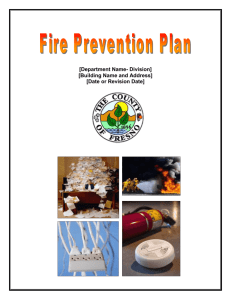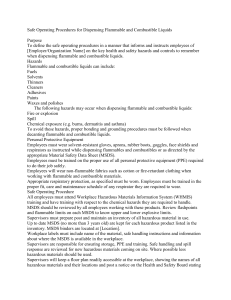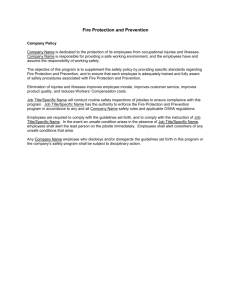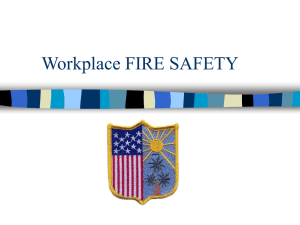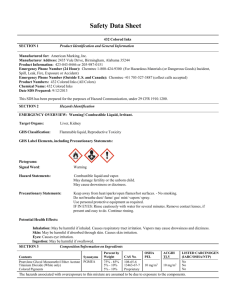UMD Fire Prevention Plan - University of Minnesota Duluth
advertisement
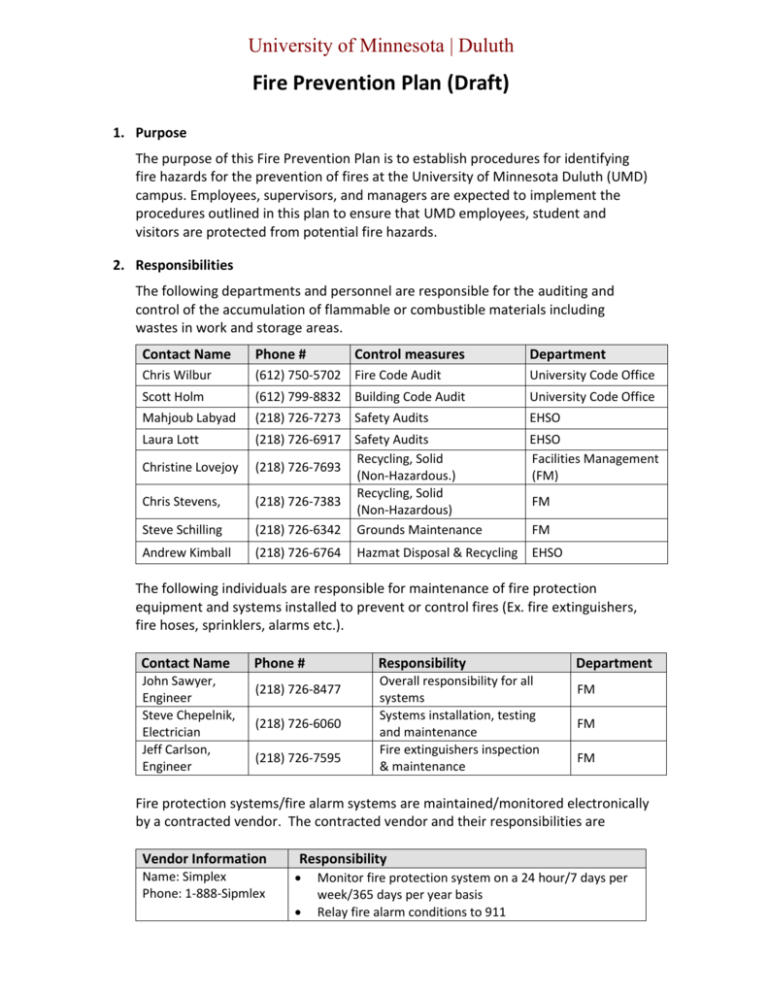
University of Minnesota | Duluth Fire Prevention Plan (Draft) 1. Purpose The purpose of this Fire Prevention Plan is to establish procedures for identifying fire hazards for the prevention of fires at the University of Minnesota Duluth (UMD) campus. Employees, supervisors, and managers are expected to implement the procedures outlined in this plan to ensure that UMD employees, student and visitors are protected from potential fire hazards. 2. Responsibilities The following departments and personnel are responsible for the auditing and control of the accumulation of flammable or combustible materials including wastes in work and storage areas. Contact Name Phone # Chris Wilbur (612) 750-5702 Fire Code Audit University Code Office Scott Holm (612) 799-8832 Building Code Audit University Code Office Mahjoub Labyad (218) 726-7273 Safety Audits EHSO Laura Lott EHSO Facilities Management (FM) Steve Schilling (218) 726-6917 Safety Audits Recycling, Solid (218) 726-7693 (Non-Hazardous.) Recycling, Solid (218) 726-7383 (Non-Hazardous) (218) 726-6342 Grounds Maintenance Andrew Kimball (218) 726-6764 EHSO Christine Lovejoy Chris Stevens, Control measures Hazmat Disposal & Recycling Department FM FM The following individuals are responsible for maintenance of fire protection equipment and systems installed to prevent or control fires (Ex. fire extinguishers, fire hoses, sprinklers, alarms etc.). Contact Name John Sawyer, Engineer Steve Chepelnik, Electrician Jeff Carlson, Engineer Phone # Responsibility (218) 726-8477 (218) 726-6060 (218) 726-7595 Overall responsibility for all systems Systems installation, testing and maintenance Fire extinguishers inspection & maintenance Department FM FM FM Fire protection systems/fire alarm systems are maintained/monitored electronically by a contracted vendor. The contracted vendor and their responsibilities are Vendor Information Name: Simplex Phone: 1-888-Sipmlex Responsibility Monitor fire protection system on a 24 hour/7 days per week/365 days per year basis Relay fire alarm conditions to 911 UNIVERSITY OF MINNESOTA | DULUTH Fire Prevention Plan 3. Identification of Fire Hazards The following is a list of potential fire hazards by work areas. Work Areas Fire Hazards Laboratories Flammable & combustible liquids including wastes Flammable solids Electrical, electronic equipment Combustible paper, cardboard and Plastics Heat producing equipment and appliances Flammable gases Computer labs VDT, printers, electrical Plastic, paper, cardboard Chemical Store room Flammable and combustible liquids Flammable solids Plastics, cardboard, and paper Electrical appliances Shops and work rooms Paper, plastic, electrical, oils, flammable and combustible liquids, combustible dusts, Hot work/Open Flame Flammable gases Employee break/lunch rooms Paper, plastic, electrical appliances Employee offices Paper, electrical, VDT, plastic, printers Large cooking appliances, grills, catering equipment, heating sources, oils, grease Flammable, combustible, soldering, hot works Kitchen Theatre 4. Fire Protection Best Practices The following are fire prevention best practices by type of fire hazards. Type of Fire Hazard Fire Prevention Practices Paper Plastic Electrical October 2013 Waste paper is removed and recycled regularly per custodial standard Stored paper is managed to prevent fires by keeping paper away from ignition sources, storing in metal file cabinets etc. Practice good housekeeping to avoid fire loading Waste plastic is discarded or recycled regularly per custodial standards Regular safety inspections of laboratories, shops, workrooms, storage rooms etc., are conducted to ensure electrical hazards are identified and abated; outlets, multi strips, and extension cords are used properly and in good condition; and 2 UNIVERSITY OF MINNESOTA | DULUTH Fire Prevention Plan access to electrical power boxes are free from obstructions. Laboratory and storage areas inspections are conducted regularly to ensure flammable and combustible material storage is within allowable quantities, in approved containers and in accordance with the UMD chemical storage guide. Flammable wastes are managed according to state and federal hazardous waste rules Hot work permit procedures are implemented for any heat producing operation, or operations involving open flames and sparks. Hot work includes welding, brazing, grinding, soldering, cutting, and torch applied or removed materials (see UMD Hot Wok permit requirements) Flammable/Combustible liquids and gases Hot Work/Open flame 5. Fire Safe Work practices Flammable liquids or gases, combustibles including, boxes, books, rags, clothing, or trash shall not be placed or stored near heaters or their vents, any electrical appliance, or other potential sources of ignition. All Hazardous Materials are to be stored according to the UMD Chemical Storage Guide and the UMD Flammable Chemical Storage Guide Sources of actual or potential heat such as hot plates are not to be placed near flammable or combustible materials. Candle burning is not allowed at UMD, and only specific portable space heaters are acceptable Care must be taken not to block fire escape routes with any materials, particularly with flammable or combustible materials. A minimum of 44" clear path of travel shall be provided in all exit corridors. o Flammable liquids or other hazardous material storage is not permitted in any corridors and stairways, or exit route. o No storage of any type is allowed in any part of a space considered as exit route. Access to safety showers, eyewashes, fire extinguishers, exit doors, fire alarm pull stations and electrical panels are to be maintained free of obstructions. All equipment/storage in any corridor shall be temporary (less than 3 months) shall allow for the 44” clear Path, and shall be clearly labeled with the owner's name, address, and phone number, date it was placed in storage as well as approximate removal date. Each individual department will make sure that disposition of flammable hazardous waste is done on a regular basis to ensure the quantity of flammable materials stored in the space stay within the allowable limit. Flammable chemicals and other hazardous material storage shall be kept to a minimum (in use only). October 2013 3 UNIVERSITY OF MINNESOTA | DULUTH Fire Prevention Plan Extension cords and multiple plugs are to be maintained in good condition, free of defects and are not to be used in lieu of permanent wiring. Cord and plug connected equipment that is defective in any way is not to be used and must be immediately taken out of service for repair. 6. Fire Control Measures Most Buildings on the UMD campus are equipped with a monitored fire alarm system. Also, the majority of the Buildings are equipped with fire protection sprinklers. The following is a list of fire control measures Work Areas Fire Control Measures All buildings Monitored sprinkler system Monitored fire alarm system Fire doors and separations Fire extinguishers The following Fire Extinguishers types and quantities are used at UMD Type Total Number ABC CO2 Halon 1028 114 12 7. Maintenance and Inspection Program The periodic maintenance, inspection and testing frequencies for fire control systems are as follows Fire Control Measures Inspection/Testing Frequency UMD Contractor Fire Alarm System Annual Sprinkler System Annual Fire Extinguishers Monthly inspections Annual inspections and testing FM FM FM (visual, Summit monthly) FM Contractor (bid) 10. Employee Response to Fire Emergencies Employees are instructed during Fire Safety and Emergency Preparedness training that they are not required to extinguish incipient fires with the provided fire extinguishers, but should sound the alarm to alert others in the building, and evacuate immediately. Employees are not to use the fire extinguishers unless they have been trained and are familiar with the safe circumstances of its use. Employee response to fire emergencies is outlined in the UMD Beep Plan. October 2013 4 UNIVERSITY OF MINNESOTA | DULUTH Fire Prevention Plan 11. Training Employees are apprised of the potential fire hazards of the materials and processes they are routinely exposed to and fire safe work practices during the Fire Safety and Emergency Preparedness training. Upon initial assignment, employees should be made aware of the key parts of this Fire Prevention plan and the Building Emergency Evacuation plan (BEEP) by their supervisor, to protect them in the event of an emergency. This Fire Prevention Plan along with the BEEP plan are located in all departments’ head offices, on the UMD EHSO web site and will be made available for review by employees upon their request. The UMD Office of Environmental Health and Safety reviews this plan annually for any needed changes or updates. For further information on Emergency preparedness or this plan, please contact Mahjoub Labyad at (218) 726-7273 or mlabyad@d.umn.edu or Laura Lott at (218) 726-6917 or llott@d.umn.edu 8. Legal Reference October 2013 29 CFR 1910.38 - Fire Prevention Plans Minnesota Fire Safety Code. 5
